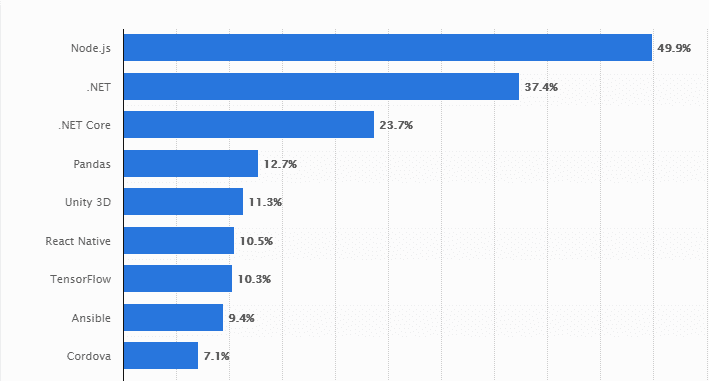ⓘ Featured image: Freepik
If you are a web developer, who’s looking to switch to backend development with JavaScript, Node JS will help you excel at work. To structure your learning journey better, you should know the industry trends. Node JS is a JavaScript-based framework using which you can develop and deploy backend and server-side applications. JavaScript lies at the core of this framework, so if you know JavaScript pretty well, you can try out working with this framework pretty quickly.
In recent times, the usage and demand for this framework have multiplied many times, and it is the number one choice of many developers. This is also a reason why businesses are looking to hire node.js developers in recent times. Being based on JavaScript opens the doors of this language to many people, and the benefits that it provides keep people hooked to this language.
JOIN US TO STAY UPDATED ON YOUR FAVORITE MESSENGER APP!

It is easier to learn if you have some experience in JavaScript and backend development. To ease down the development tasks furthermore, NodeJS has libraries that can be used to develop applications, so let’s have a look at some prominent NodeJS libraries.

Node.Js Libraries
- Koa.js
- Meteor.js
- Express.js
- Sails.js
- Total.js
The community loves NodeJS, and they prefer building apps on this web framework, so why not have a look at the Node.js trends for 2022.
Top Node.js Trends That Will Dominate In 2022
1. Real-Time Applications
NodeJS has introduced a new type of application, and people seem to love it. Due to its non-blocking IO model and threading capabilities, NodeJS has a blazing fast performance speed.
It can process requests at the speed of light and provide output in almost real-time. Real-time applications are ideal in situations requiring instant data transfer from the server without a microsecond delay.
2022 is just the trailer for NodeJS real-time application’s demand. As we advance to solve more time-critical problems in the aviation, healthcare, and industrial sector, the demand for Node JS based real-time applications will go through the roof. You’ll see this trend evolving through 2022 and even further. So try to skill up and learn to build real-time applications with NodeJS to be in demand.
2. Going Serverless
Since cloud computing has become mainstream, the prices of these services have decreased significantly. Moreover, cloud computing services also provide more incredible benefits to the business when compared to using self-hosted hardware for servers and data centres.
Many businesses have made the jump and have become entirely serverless. This means that all their applications are deployed in public or private clouds hosted by cloud service providers. This gives a considerable cost decrease and increases the availability of web applications.
NodeJS can accommodate microservices architecture pretty quickly, and that makes it an ideal choice to go serverless. When you build robust microservices and APIs in NodeJS, you can quickly deploy them on cloud servers, and there will be no performance limitations.
Moreover, you’ll get improved response time with high-performing cloud servers, and a significant decrease in developmental expenses can be observed.
3. GraphQL
GraphQL is a modern database structure based on graphs. In this type of database, the data is stored on vertices, and the edges act as keys. Storing and retrieving data from graph-based databases like graphQL is super fast and easy.
Due to this, we will see a boost in the usage of GraphQL databases with NodeJS in the coming years. Since its launch, the use and demand of GraphQL have multiplied many times. Developers also feel pretty comfortable with this database, and the speed of operations is unmatchable.
All these things make GraphQL a good choice for the Node JS based applications that require superfast input and output results from the database.
4. Increased Usage Of MEAN & MERN Stack
Developing web applications becomes more manageable when the frontend and backend both comprise JavaScript, and the MEAN & MERN stacks provide this benefit.
The MEAN stack refers to MongoDB, paired with Express, Angular, and NodeJS, which is a good choice when dealing with large enterprise-scale applications. MEAN stack should be used when you want to develop applications with routes and redirections and make it look like a web application.
On the other hand, the MERN stack refers to MongoDB, teamed with Express, ReactJS, and NodeJS. Using this stack, you can create lightning-fast single-page based web applications that can handle real-time data transfers and updates. You should use the MERN stack when you are looking to eliminate the use of routes across the website and make it look like only a single-page application.
Because Node JS is used in both these stacks, when the demand for MERN & MEAN stacks increases, you will see a positive trend for the usage of Node JS.
5. IoT Development
IoT is a futuristic technology that will ease down our lives primarily, but developing and sustaining such systems is hard. IoT applications process tons of data, and you need to use a high-speed and scalable language.
In IoT, mechanical devices are connected to central systems, and they are monitored and even given their own small brain to think and do the right thing. This increases the data produced throughout the process, and due to this, IoT systems are hard to maintain. One slight inconsistency in the data can change the whole flow of the application, and anything can happen when large industrial machinery is interconnected in the environment.
NodeJS seems to be the only language capable of overcoming all these problems at once. It has a super-fast processing speed that can transfer data in real-time conditions and provide the application with the latest data throughout the cycle.
Due to pandemics, companies are looking to adopt IoT technology to power their factories and decrease dependency on the workers. Being the best choice to power IoT applications, Node JS will surely trend through 2022 and in the future as companies try to leverage this futuristic technology.
NodeJS has the best community, so even if you try some innovation, you’ll get good support on all the problems that you might face during the time. If you tend to move along the trend, choose Node JS for 2022, and keep an eye on these trends, you will indeed have an easy time developing and shipping applications.
ⓘ As part of our ongoing support for startups and SMEs, LAFFAZ Media publishes feature and resource articles that may include references and links to external websites. These inclusions are selected at our editorial discretion to provide valuable information to our readers. LAFFAZ Media does not control, endorse, or assume responsibility for the content or practices of external websites. For more details, please refer to our Terms and Conditions.





